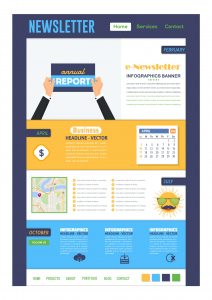Beginner’s Guide to Sending Email Newsletters
With the rise of artificial intelligence, messenger chatbots, virtual reality and SMS marketing, it can sometimes seem like traditional forms of marketing, like email newsletters, aren’t worth the time or the hassle.
Businesses are always looking for ways to stay “top-of-mind” for their target audience. And while sending email newsletters may not seem like the trendiest things to do, it’s an effective way to reach your audience and to keep them remembering you.
The Do’s and Don’ts of Email Newsletters
- – Do make it personal
- – Do clearly include unsubscribe options
- – Do ensure the content is relevant to the recipients
- – Don’t send your newsletters too often
- – Don’t overload recipients with too much information
- – Don’t feature too many images
5 Steps to Sending Email Newsletters
1. Decide Your Frequency
How often are you going to send them? Quarterly, monthly or weekly? It depends on your audience; how often do you expect they would like to see your content.
Think about segmenting your mailing list – perhaps some recipients are more engaged than others and would like to hear from you more often?
If you start of with sending your newsletter once a month, you can always increase the frequency to every two weeks or weekly if you want.
2. What’s the Point?
Company newsletters typically help brands interact with their audience and build relationships with their leads and customers.
But each newsletter you send should have its own specific objective, whether it be to raise awareness of a specific product or to encourage recipients to read your latest blog posts.
Check out our blog post How to Set Your Own SMART Goals for 2019 to explore how setting specific goals will help you to keep on track.
3. Collect Your Content
You have a few options:
- – Use your recent content
- – Feature all your content about a specific product / service
- – Include your popular content
- – Or a mix!
4. Design Your Template
- – Less is more
- – Don’t change the template (have a revamp a year)
- – Remember your brand guidelines
- – Feature eye-catching images
The design is down to you – but mailing providers like Mail Chimp and Constant Contact offer some good templates you can use.
5. Set Your Expectations
To avoid aggravating your recipients, it’s important you remain transparent and let them know what they’re involved in:
- – Tell them how they can unsubscribe
- – How often they will be hearing from you
- – What your emails will typically detail
- – Who the emails will be sent from
The rest is down to you create your email newsletter, test them and listen to what your recipients think.
Keep an eye on your open, CTR and unsubscribe rates. They’re a good indicator as to how well your newsletters are performing.
To help, use our email marketing blog posts: